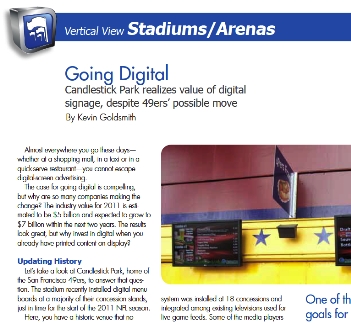GOING DIGITAL-CANDLESTICK PARK REALIZES VALUE OF DIGITAL SIGNAGE, DESPITE 49ERS’ POSSIBLE MOVE

Almost everywhere you go these days—whether at a shopping mall, in a taxi or in a quick-serve restaurant—you cannot escape digital-screen advertising.
The case for going digital is compelling, but why are so many companies making the change? The industry value for 2011 is estimated to be $5 billion and expected to grow to $7 billion within the next two years. The results look great, but why invest in digital when you already have printed content on display?
Updating History
Let’s take a look at Candlestick Park, home of the San Francisco 49ers, to answer that question. The stadium recently installed digital menu boards at a majority of their concession stands, just in time for the start of the 2011 NFL season.
Here, you have a historic venue that no longer fulfills the needs of the team, which is actively seeking to relocate to Santa Clara. Despite the possible move, the team and concessionaire realized the value of implementing a digital menu board network, even if it is for a short term.
The 49ers installation comprised 54 42-inch LG commercial monitors and 41 LG NC2000 embedded media players running a Web-based content management platform. The system was installed at 18 concessions and integrated among existing televisions used for live game feeds. Some of the media players drive multiple displays through cloning. Content management for the digital menu boards is administered by an online Web application that enables content to be updated from anywhere on any Web-connected device, such as a PC, smart phone or tablet computer.
Determining Success
In a case like this, many look for the hard ROI and ask how will this increase turnover, per caps and overall margin. But there are many factors that affect the success of digital menu boards other than the direct impact on dollars and percent growth—which, according to industry sources, yields anywhere from 5 to 10 percent. The 49ers looked at the total value of converting to a digital solution, not just the financial return.
One of the most common goals for sports venues is to improve customer experience and perception. Standing in line for five minutes doesn’t feel like five minutes when digital menu boards have been deployed.
A daily selection of the top stories for AV integrators, resellers and consultants. Sign up below.
The 49ers put great emphasis on ensuring fans’ safety and well-being. They worked closely with Ping HD’s content design team and achieved vibrant and dynamic menus designed for maximum impact. Included is a zoned partition that delivers strategic messages to fans, such as the location of the nearest first-aid station and a powerful Department of Homeland Security message that states: “See something, say something. There are over 120,000 eyes at today’s game. Help us create and maintain a safe and enjoyable experience on game day.”
Converting to digital also enables a venue to direct business to other on-site cost centers. In the case of the 49ers, this includes direction to other concessions that sell different types of food, where to buy official team merchandise, tickets for the next home game, concerts and other upcoming events happening at the stadium. The screens also promote fan-loyalty competitions.
From a food-service perspective, the primary benefit of digital menu boards is how it brings the offerings to life, for example, by showing video of a mouth-watering burger being grilled. Other benefits include promoting combo meals and the ability to quickly change pricing and product offerings based on the event.
The Other Side of the Coin
Not surprisingly, digital menu boards can generate additional revenue in many ways. But they also bring cost savings. For example, the flexibility of a digital menu board solution enables concessionaires to change the menus throughout the stadium within minutes. It used to take the San Francisco Giants at AT&T Park one week to change the stadium’s menu content for a concert or other non-baseball event.
Savings are also achieved by eliminating the printing costs associated with static menu board changes. By going digital, content managers are ensured the information is uniform across the venue.
